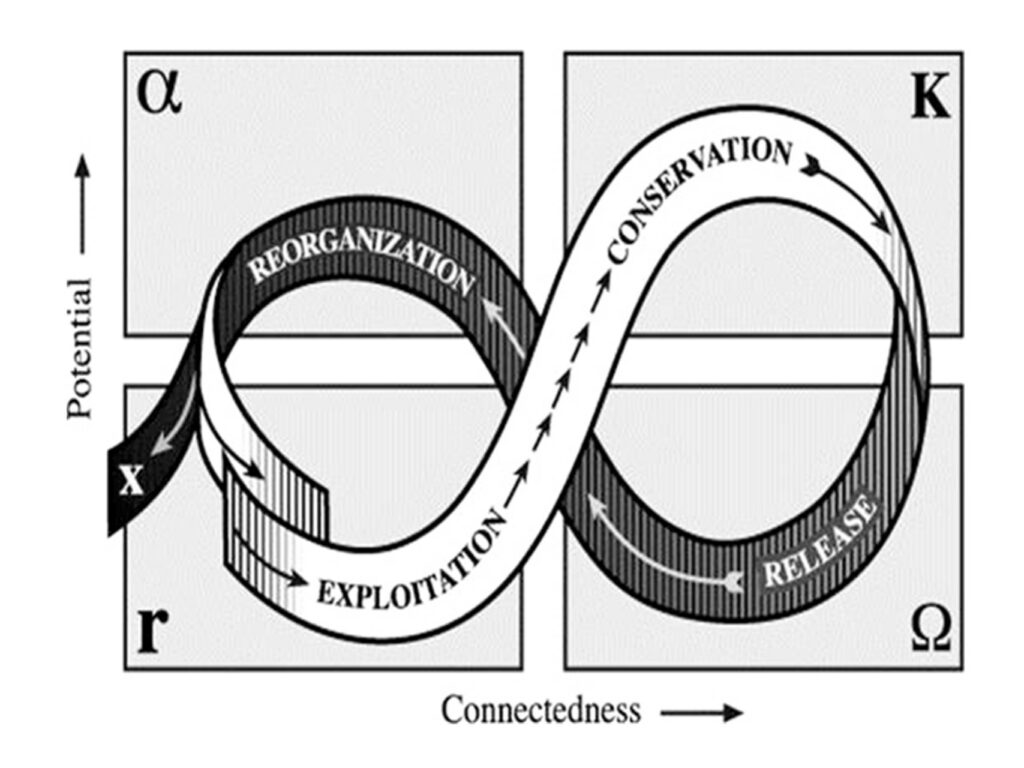David P. Turner / May 23, 2025

Stylized image of Earth and its AI-infused technosphere. Image Credit: MS CoPilot.
Introduction
The technosphere is increasingly impacting core features of the Earth system, notably the climate and the biosphere.
Accordingly, there is wide recognition that we humans (with the usual caveats about the meaning of “we” here) need to rein in (tame) the technosphere.
However, this project does not amount to just putting constraints on existing technology; new technologies designed to harvest, synthesize, and act on vast arrays of digital data are also needed.
The idea of managing the technosphere, or indeed the Earth system, has an obvious air of hubris. But the technosphere is unquestionably having global scale deleterious impacts on the Earth system, and the human responsibility to do something about it is clear.
Notable recent changes in the technosphere that will help with global management include the arrival of well-functioning Artificial Intelligence (AI) tools like large language models (LLMs) and neural network-based machine learning algorithms. Along with the information plenitude referred to in my title ̶ a product of the recent trend to digitize all information, be it in the form of text, images, audio, or video ̶ some hope of grasping global scale dynamics is emerging.
AI provides a fundamentally new way of thinking – beyond historical faith-based and reason-based approaches. The human thinking apparatus – our brain – simply does not have the capacity to assimilate and synthesize information at the scale with which it is being produced. Fortunately, AI algorithms in combination with massive computing power and vast observational data sets can often do the job. One great strength is that they can search the solution space of a problem more thoroughly than the unassisted human mind.
AI might also be considered analogous to a new source of energy. Just as fossil fuels freed up our bodies to do more interesting and less labor-intensive activities, AI is freeing up our minds to do more fulfilling and less routine activities, including attending to sustainability at local to global scales.
The Role of AI in Earth System Management
Managing a socio-ecological system (such as the Earth system) requires monitoring the system, developing a model to assimilate observations of the system and help with understanding and planning, and organizing a deliberative body to make decisions.
The relevant global scale monitoring data includes observations of the metabolism and growth of the technosphere and the biosphere, along with tracking of the real time behavior of other parts of the Earth system, e.g. AI machine learning has proved useful in satellite-based monitoring of deforestation.
The relevant models could be 1) process-based Earth system simulation models, e.g. that include a representation of the global climate as well as social subsystems, 2) mechanism-free data driven models based on AI-assisted pattern analysis, or 3) combinations of these two approaches.
As far as deliberative bodies, the world is dangerously short of global governance infrastructure. United Nations sponsored efforts such as the Paris Climate Accords are only a shadow of what is needed. AI may be helpful in generating and summarizing relevant data, though of course the bigger challenge is with human capacity and willingness to change. Ultimately, superintelligent AI might have features that make it better at devising optimal choices about global governance than (mere) humans could come up with.
Use Cases That Already Effectively Combine AI with Massive Data Sets
1) AI management of regional electricity grids. Management of regional electricity grids has become much more complicated as they transition from traditional base-load power plants to supply by renewable sources. The intermittency of wind and solar, as well as variation in the scale of the inputs (roof-top to utility-scale operations in the case of solar energy), are particularly challenging. Smart grids must be capable of sending and receiving power from a multitude of individual customers, and maintaining dynamic pricing to balance power consumption during periods of high and low demand.
Fortunately, machine learning is effective at assimilating a blizzard of power system data, and in making automated decisions that link energy supply and demand.
2. Use of meteorological observations, climate models, and AI to develop early warning systems for extreme weather events. The incidence of extreme weather events (EWEs) such as floods, droughts, and fire is increasing because of anthropogenically-driven climate change. Associated human fatalities, and damage to technosphere infrastructure, are correspondingly rising.
Weather forecasting tools like regional weather models have significant limitations with respect to forecasting EWEs. These models are regularly updated by observations, and they project conditions into the near future based on simulating physical processes such as wind, precipitation, and heat transfer. The model limitations show up in terms of the kinds of information they can assimilate, and in representing physical processes at the proper spatial and temporal scale.
An alternative weather forecasting approach uses AI (machine learning) to assimilate a much broader array of observations. This approach largely leaves physical mechanisms behind and is said to be “data driven”, i.e. based on statistical relationships between historical observations of the causes and effects of weather change. The forecast of an extreme weather event from this approach can be promptly fed to appropriate emergency response organizations that act to make relevant preparations and increase local resilience.
Beyond weather forecasting, the machine learning approach is beginning to be used in applications based on Earth system digital twins. A digital twin can be used to simulate alternative scenarios and may have embedded one or more process-based simulation models. As model complexity increases, e.g. by adding models of social subsystems, a machine learning-based model may prove to be more effective.
A critical point here is that mass observations of weather and ground data are needed to train and drive an AI-based model. In that regard, the recent focus on shrinking federal agencies like NOAA, NASA, and EPA, which make critical environmental observations, is particularly counterproductive.
3) Use of Large Language Models (LLMs) in Earth System Science education and advocacy.
The technosphere is creating vast amounts of textual, graphical, and video information specifically about global environmental change, including peer-reviewed journal articles, books, periodicals, blogs, and NGO reports. The more that people use this information to understand what is happening in the Earth system, and what could be done about it, the better chance we have of making needed changes in the technosphere (e.g. reducing greenhouse gas emissions).
Domain-specific LLMs (e.g. Earth Copilot) have an important role to play in this aspiration because they can, with infinite patience, communicate a synthesis of the scientific consensus on a given topic at an appropriate level of learning ability (i.e. level of education).
Certainly, an LLM can produce wrong answers at times. The output of an LLM depends on the data used in its training, the manner in which it is fine-tuned, and new web-based information that it employs in response to a specific prompt. Errors or lies in the training data may thus leak into the outputs. Already, researchers have found policy relevant differences among the most used AI-chatbots, and bad actors are creating web sites with false information purely for the consumption of AI web crawlers that scrape the web seeking new information.
Despite the resistance of LLM creators to having their training data censored, more care is needed. It is also important to continually expand, by way of further research, the range of concepts and ideas used in training data.
Conclusion
AI gives us the ability to access, synthesize, and manage the contemporary plenitude of digital information. Early successful applications of AI include management of regional electric grids, forecasting of Extreme Weather Events, and facilitating learning about Earth System Science. Given that human progress in managing the technosphere is incommensurate with the damage the technosphere is doing to the Earth system, the range of potential applications is immense. “We” must continue to develop them.
Credits
The lead image was created by collaboration with MS CoPilot, and some of the links were inspired by Perplexity.AI. The text, with all its human flaws, is of my own hand. Taming the Technosphere blog posts are apparently used by the web scrappers that collect training data for AI LLMs, and are used (sometimes with attribution) for query-related responses by AI-assisted chatbots.





